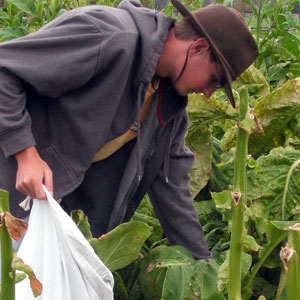In the field and in the laboratory, researchers are investigating ways to optimize nicotine concentration in tobacco for the noncombustible market.
By Julia Ellis
U.S. tobacco has traditionally been prized for its taste and quality. In the e-liquid market, however, taste is irrelevant. Nicotine content is the valued commodity. Currently India and China are known as the major producers of tobacco for e-liquids, but the U.S. may be able to find a niche in the nicotine market.
With the combination of buyer mistrust of foreign exports and U.S. brand loyalty, the “Made in the USA” label could help U.S. growers sell tobacco for nicotine extraction. Companies like AmeriNic, the Universal Leaf subsidiary that claims to have “the first nicotine 100 percent manufactured in the USA,” are banking on this.
So how can growers optimize nicotine yield in tobacco plants to get more bang for their growing buck?
Nicotine Basics
The weather, amount of applied nitrogen and tobacco variety all play a role in nicotine production. Because the amount of nicotine in the plant is governed by root development, growing seasons that are characterized by a lot of early rain lead to smaller roots and therefore less nicotine.
In addition to limiting root growth, wet weather and, consequently, wet soil can leach away nitrogen, which is also necessary for nicotine production. The tobacco plant’s nitrogen use for nicotine synthesis and its topping height are linked. When a plant is topped, a greater percentage of nitrogen use in the plant goes to making nicotine.
Nicotine yield also depends on variety grown. Different varieties have different inherent nicotine levels.
Field Methods
Growers for the e-liquid market may be able to boost their nicotine production through practices in the field. The University of Kentucky’s Kentucky Tobacco Research and Development Center (KTRDC) is investigating field methods to optimize the nicotine yield from tobacco. The goal of their research is to help U.S.-based production of tobacco for e-liquid production.
Funded by the Council for Burley Tobacco, the KTRDC project is comparing nicotine yields in three varieties: TN 90LC (burley), Narrow Leaf Madole (dark) and TI 401 (noncommercial). When measuring nicotine content, a comparison nicotine level is needed. In this experiment, the TN 90LC is used to get a baseline nicotine content. Plants in each variety are treated with 200 units of nitrogen per acre and 400 units of nitrogen per acre. Topping height is also being examined, with topping at standard height, as well as standard height minus 25 percent. This is done by counting leaves at standard topping height and removing an additional 25 percent for a low top.
For each treatment, there are four replications, and there are 30 plants to a plot. Plants from each treatment are harvested separately, and leaves are primed into cotton bags. They are dried and ground; then subsamples are sent to the lab and nicotine percent dry weight is measured.
Researchers also compared methods of nicotine extraction, looking at extraction from fresh versus dried tobacco. The amount of nicotine extracted was similar for the two methods, but extraction from dried leaf was more convenient.
When the goal of the harvest is total nicotine extraction, leaves do not need to be protected as much. In other words, if the leaves are going to be chopped up anyway, mechanical topping might be more cost-effective for a grower. The KTRDC project is also examining mechanical topping and comparing nicotine yield to nicotine yield of hand-topped tobacco using the same varieties. J. Patrick Perry, research farm technician at KTRDC, explains, “The main thing is that because the tobacco is not getting graded and we’re looking at whole biomass, mechanical topping could lower labor costs.”
The KTRDC team awaits results for 2016. A poor growing season in 2015 did not yield conclusive results. After examining this year’s results, the researchers will determine if modifications are necessary for next year’s trials. Other components may be added to further optimize efficiency of field production.
Molecular Methods
Researchers at North Carolina State University (NCSU) are looking at genetic factors to enhance nicotine in tobacco. Scientists from Dr. Rongda Qu’s lab overexpressed a transcription factor gene, and nicotine levels went up by 70 to 100 percent. Qu explains, “Although the plant growth was slightly affected, overall, the nicotine yield still increased on a per-acre basis.”
Increasing nicotine production may cause the plant to have fewer resources for leaf growth. Also, when a plant starts making a lot of nicotine, a molecular shutoff switch is tripped, which signals the plant to stop producing nicotine. Previous studies have indicated that too much nicotine can be toxic to root cells.
Growing for Nicotine
Because optimum varieties and field methods differ depending on the desired market, growers will have to decide if they are growing tobacco for the cigarette market or the e-liquid market, says Anne Jack, research specialist at the KTRDC. “I promise you, you would not want to grow one crop for both. A high-nicotine tobacco produced for the e-liquid market would be quite unsuitable for cigarette production.”
For one thing, nicotine content in cigarettes must fall within very narrow limits. Additionally, consistency is prized by smokers. “A high-nicotine cigarette would be unsmokable,” Jack says.
Most experts encourage growers to stick with their contracts for the tobacco market. As for now, the market for e-liquids requires less leaf than tobacco companies and growers would like. Blake Brown, economist at NCSU, is “skeptical the market will require a lot of production.”




